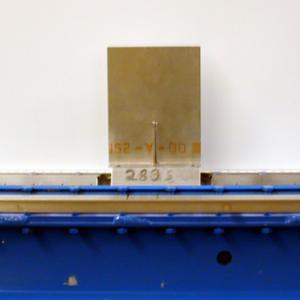College of Liberal Arts & Sciences
1C10.25 - Air Track - Constant Velocity
Level the air track and using the desired car show a constant velocity. The best way to do this is to start the car near one end of the air track. Move the car towards the nearest bumper and after it hits the car should be moving at a constant velocity through out the length of the track.
- Marciano Santamaria Lezcano, Evgeni Svenk Cruz de Garcia, Lucio Strazzabosco Dorneles, "Kinematics in One Dimension-A Smartphone Approach", TPT, Vol. 61, #7, Oct. 2023, p. 594.
- David S. Abbott, "Wavelength, Frequency, and Constant Speed Buggies", TPT, Vol. 53, #8, Nov. 2015, p. 502.
- Walter Hellman, "Galilean Tracks in the Physics Lab", TPT, Vol. 49, #8, Nov. 2011, p. 474.
- D. P. Wick and W. M. Ramsdell, "Experimenting With Electric Trains", TPT, Vol. 45, #3, Mar. 2007, p. 142.
- Edwin Kaiser, "Instantaneous Velocity: A Different Approach", TPT, Vol. 29, #6, Sept. 1991, p. 394.
- Robert Gardner, "Constant Velocity: An Uphill Run", TPT, Vol. 18, #5, May 1980, p. 382.
- Vassilis Stavrinidis, Edited by Karl Mamola, "A Mechanical Glider Launcher for the Air Track", Apparatus for Teaching Physics, p. 85.
Disclaimer: These demonstrations are provided only for illustrative use by persons affiliated with The University of Iowa and only under the direction of a trained instructor or physicist. The University of Iowa is not responsible for demonstrations performed by those using their own equipment or who choose to use this reference material for their own purpose. The demonstrations included here are within the public domain and can be found in materials contained in libraries, bookstores, and through electronic sources. Performing all or any portion of any of these demonstrations, with or without revisions not depicted here entails inherent risks. These risks include, without limitation, bodily injury (and possibly death), including risks to health that may be temporary or permanent and that may exacerbate a pre-existing medical condition; and property loss or damage. Anyone performing any part of these demonstrations, even with revisions, knowingly and voluntarily assumes all risks associated with them.
